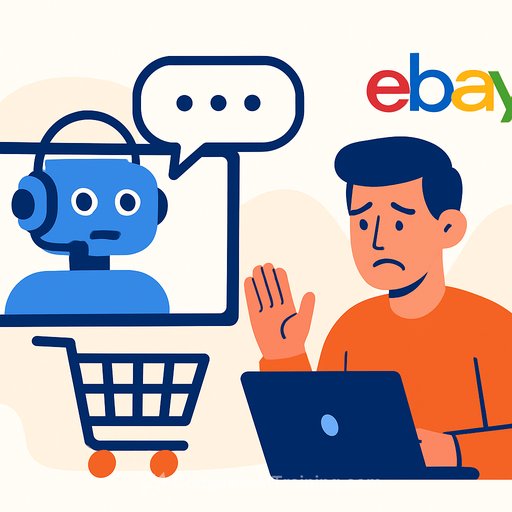eBay Doubles Down On AI Customer Service To Cut Costs And Push GMV
eBay is pushing harder on AI-led support. The pitch is hyper-personalized experiences, but the underlying goal is clear: reduce headcount costs and drive Gross Merchandise Volume.
Support leaders should pay attention. This is a live case study in how aggressive automation collides with seller expectations for real, human help.
New Leadership, Familiar Playbook
eBay moved former US GM Dawn Block into the Global Customer Experience role, covering both buyers and sellers. Hopes for a reset are running into reality as new roles and job ads emphasize AI-first support at scale.
A Senior Director of CX Engineering role calls for "leveraging AI to redefine our customer journey." The language says customer-centric, but sellers hear cost-centric. There's a widening gap between what eBay wants to optimize and what sellers say they need.
What Sellers Are Experiencing
- More deflection into AI chat and auto-responses after a ~$12M overhaul in 2023.
- "Have us call you" tests that some fear are bot-led rather than human callbacks.
- Concierge support pulled from long-time sellers with no warning, tied to a shifting top-10% GMV threshold.
- Executives touting AI that reads long seller emails and drafts initial responses to speed throughput.
The message sellers are taking away: efficiency first, empathy second. That tradeoff is showing up in trust, retention, and word-of-mouth.
Lessons Support Leaders Can Take Right Now
- Match the tool to the task. Use AI for triage, simple policy lookups, and status checks. Route disputes, appeals, and high-value accounts to humans fast.
- Label AI clearly. Ask for consent to continue with the bot. Provide one-click "talk to a person" with transparent wait times.
- Set firm escalation rules. If confidence is low, sentiment drops, or the customer asks twice-escalate. No endless loops.
- Measure beyond cost. Track CSAT by contact type (bot vs. human), first-contact resolution, recontact rate within 7 days, and churn risk after support interactions.
- Guardrails for policy enforcement. AI can flag; humans decide. False positives here burn trust and invite regulatory risk.
- Don't weaponize thresholds. If you change access to higher-tier support, give notice, criteria, and a path back.
- Close the loop with sellers. Publish change logs, run open Q&As, and share what you're testing before rollout.
Where AI Helps - And Where It Hurts
- Good bets: intent detection, summarizing long messages, auto-filling forms, policy snippet retrieval, proactive status updates, fraud pattern spotting.
- Handle with care: account restrictions, appeals, refunds over threshold, policy violations, item removals, trust and safety actions.
- Red lines: no auto-enforcement without human review on actions that affect income, inventory, or reputation.
Concierge Fallout: A Signal, Not A Footnote
Removing Concierge access for sellers who don't hit a moving top-10% GMV line sends a clear message: premium help is for the biggest wallets. That might save budget now, but it raises risk across mid-tier sellers who often become tomorrow's top accounts.
If you manage tiered support, be explicit about the criteria, give a countdown, share alternatives, and create an appeals path. Anything less looks arbitrary.
A Practical Implementation Blueprint
- 30-60-90 plan: start with low-risk intents, run A/B tests, track deflection with CSAT and recontact, then expand.
- Agent co-pilot first. Let AI draft; humans send. Promote to customer-facing bots only after quality clears benchmark.
- Quality bar: require equal-or-better CSAT vs. human baseline for three consecutive weeks before scaling.
- Error economics: define the "shadow price" of bad automation (refunds, churn, compliance). Use it to cap where bots can act.
- Escalation SLA: under 2 minutes to a person for flagged intents, VIPs, or negative sentiment.
- Transparency: clearly state when customers are speaking with AI, what it can and can't do, and how to reach a human.
- Governance: human-in-the-loop reviews for policy actions, audit logs, and bias checks using a recognized framework.
Communication Is The Real Product
Sellers' top complaint isn't just slow support-it's silence on impactful changes. If you lead CX, own the comms rhythm: monthly updates, early notice on policy moves, and real dialogue beyond a small advisory bubble.
AI can help summarize and route, but trust is built by people who listen and act.
What To Watch Next At eBay
- Share of contacts resolved by AI vs. human, plus the CSAT gap.
- Clear, public criteria for higher-tier support and paths for reinstatement.
- False positive rates in policy enforcement and average time-to-appeal resolution.
- Reintroduction of guaranteed human channels for complex issues and top accounts.
Helpful Resources
- NIST AI Risk Management Framework for practical governance and guardrails.
- AI courses by job role to upskill CX teams on safe, effective automation.
Bottom line: AI can reduce handle time and clean up repetitive tasks, but it cannot carry trust on its own. If you're leading support, design your system so people feel heard, policies feel fair, and the bot knows when to step aside.
Your membership also unlocks:





